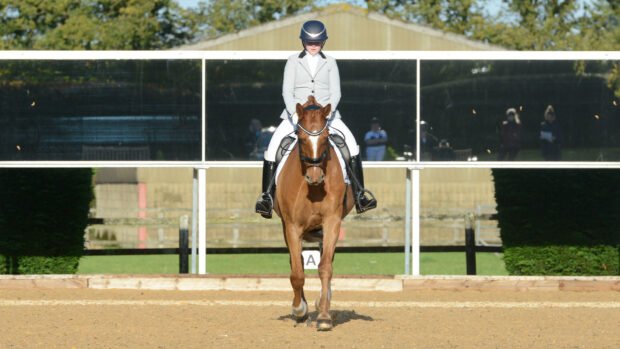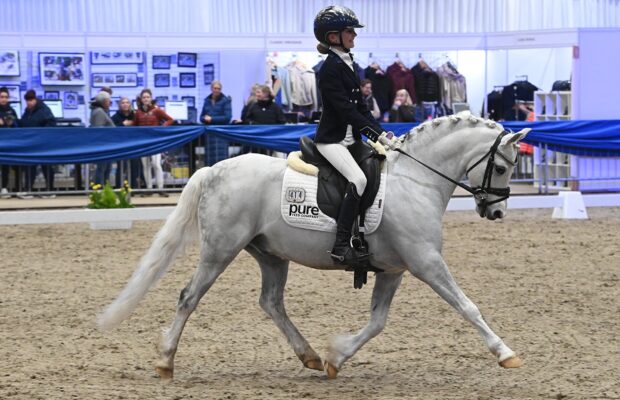Renvers is one of the more advanced examples of lateral work for horses. It mirrors the exercise travers, or quarters-in, and is a useful exercise for straightening and strengthening a horse. Learning to ride it will improve your feel as a rider, too. When riding renvers, the shoulders of the horse are controlled and positioned off the track, with the hindlegs on the track. The horse will be moving on either three or four tracks with an ideal angle of 30 degrees to the direction of travel.
British Dressage explains that renvers is the inverse movement in relation to travers. The horse’s hindquarters remain on the track while the forehand is moved inward off the track, but unlike shoulder-in, the horse is looking in the direction in which it is moving, with a bend around the rider’s inside leg (the use of “inside” in this context is related to the horse’s bend, not the position of the horse within the arena). The horse’s outside legs pass and cross in front of the inside legs.
Benefits of learning how to ride renvers to the rider
- Develops co-ordination
- Teaches the rider how to control the haunches and hind legs
- Is a useful introduction to half-pass
- Develops feel and sensitivity as a rider
Benefits of renvers to the horse
- Improves co-ordination, suppleness and athleticism
- Encourages engagement of the hocks, especially the inside hind leg
- Develops collection
- Increases obedience to the rider’s aids
- Preparation for half-pass
- Helps stop the horse falling in through its shoulder
- Prevents the horse from trying to evade his body to the rider’s hands, by over-bending in his neck and falling out through the shoulder
- Strengthens horses which are weaker on one side
- Adds something new to training
How to ride renvers

When riding renvers, the shoulders of the horse are controlled and positioned off the track, with the hindlegs on the track
Begin introducing this to the horse in walk, before moving on into trot and canter.
- The rider must be aware of their position in the saddle and be able to control their weight aids before introducing this exercise
- The rider should look ahead while sitting slightly to the inside
- The inside leg is placed by the girth and the outside leg is behind the girth
- The inside rein asks for positioning, direction and bend while the outside rein controls the amount of bend and speed
- The rider can approach renvers from a half-pirouette in walk, from half a 10m circle on to the centre line, or by riding up the outside track of an arena and turning back onto the quarter line
- To finish riding renvers, the forehand is re-aligned with the quarters on the track.
- If you are new to renvers, you should watch someone ride the movement and then ask an experienced trainer to help you ride it
Common problems
- Renvers is an advanced movement so it will take time and repetition for your horse to learn
- The horse resists the aid, so loses energy and rhythm. You must ride forward to re-establish the quality of the pace before asking again
- Too much or too little angle so the horse evades the bend
- The rider is not clear with the aid so the horse gets confused and thinks they are being asked a different question. Ensure that you fully understand what is being asked during renvers before asking the horse
Is renvers included in any British Dressage tests?
Renvers is not a compulsory movement in any British Dressage tests, although it is a permitted movement in freestyle dressage at medium level and above under British Dressage rules. It is not used in British Eventing dressage tests.
You might also be interested in:

What is shoulder-in, and how can it help my horse?
Shoulder-in is a useful exercise to increase suppleness in the horse. Here we look at the aids, common problems and

What is travers, and how can it help my horse?

How to nail the perfect half pass for training and competition
The preparation for the perfect half pass

Subscribe to Horse & Hound magazine today – and enjoy unlimited website access all year round
Horse & Hound magazine, out every Thursday, is packed with all the latest news and reports, as well as interviews, specials, nostalgia, vet and training advice. Find how you can enjoy the magazine delivered to your door every week, plus options to upgrade your subscription to access our online service that brings you breaking news and reports as well as other benefits.




